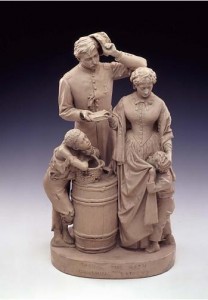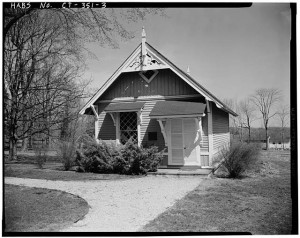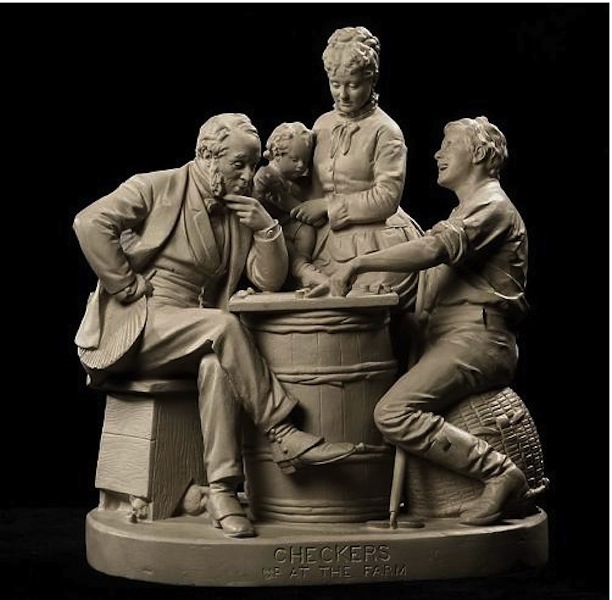John Rogers was an American sculptor whose style and production methods made his art popular with middle-class art collectors in the 19th century. His works, which evoked feelings of nostalgia and a longing for simpler times, helped Americans come to terms with the contentious issues of the Reconstruction period following the Civil War. Between 1859 and 1892, Rogers sold approximately 80,000 plaster sculptures consisting of roughly 80 different designs. He spent the latter part of his life in the quiet town of New Canaan, where in his workshop he produced some of his best-known and most-loved works.
Early Life
Born in Salem, Massachusetts, in 1829, Rogers was the son of an unsuccessful Boston merchant. Rather than going into business himself, after attending Boston’s English High School, Rogers spent six years in Manchester, New Hampshire, learning to become a master mechanic. By the age of 20, clay modeling was a favorite hobby for Rogers. When the Panic of 1857, a severe financial downtown, ended his brief stint working on the Hannibal and St. Joseph Rail Road in Missouri, he decided he wanted to become a professional sculptor.

John Rogers, Taking the Oath and Drawing Rations, 1865, painted plaster – Smithsonian American Art Museum, Gift of John Rogers and Son
Rogers went to Europe in 1858 and spent six months studying in Paris and Rome. Upon his return to the United States, he set up a business in Chicago that met with enough success to give him the confidence to put his skills on display in New York City (just prior to the outbreak of the Civil War).
Sculpting the Civil War
Rogers did not fight in the Civil War—he received his draft notice just days before General Lee surrendered at Appomattox. Instead, Rogers spent the war years sculpting. Between 1861 and 1865, he produced 14 different Civil War groups. Rather than depicting heroes or moments from great battles, Rogers’s sculptures displayed intimate moments from the home front or scenes of common soldiers in their camps during peaceful interludes.
Rogers’s most famous work (as well as his personal favorite) was Taking the Oath and Drawing Rations, originally cast in November of 1865. In it, Rogers took a sentimental look at the path of post-war reunification by focusing on the moment in which a Southern mother places her hand on the Bible to take an oath of allegiance to the United States in order to receive food rations. The Union officer and both boys gaze intently at the woman. As scholars have noted, this artistic decision by Rodgers echoes popular sentiments that traditional domestic femininity would knit together war-torn families—as well as the nation. Within months of its casting, Rogers sold 300 copies of Taking the Oath and quickly found orders for it exceeded his production capacity.
Mass Production Spurs Popularity
Using bronze master molds costing between $450 and $1,500, Rogers mass produced plaster copies of sculptures that made them affordable to the majority of American households. The popularity of these works was such that by the time the Civil War ended, Rogers employed three casters, eight finishers, and two colorists to keep up with the demand.

John Rogers Studio in New Canaan, Connecticut circa 1967 – By Robert Fulton III. Library of Congress, Prints and Photographs Division, Historic American Buildings Survey. Used through Public Domain.
Thanks in part to a decision to reach new consumers by publishing a catalogue of his works, Rogers’s business continued to grow throughout the latter half of the 19th century. His 1870 sculpture Coming to the Parson sold 8,000 copies. His 1875 Checkers Up at the Farm sold an additional 5,000 copies. All of this success helped support the construction of a studio Rogers built in New Canaan, in 1878. It was there that he spent the better part of his remaining years.
By the turn of the century, illness forced Rogers into retirement, and he died in 1904. Today, the studio in New Canaan where Rogers worked for much of his later life is a museum and is recognized by the National Park Service as a National Historic Landmark.









